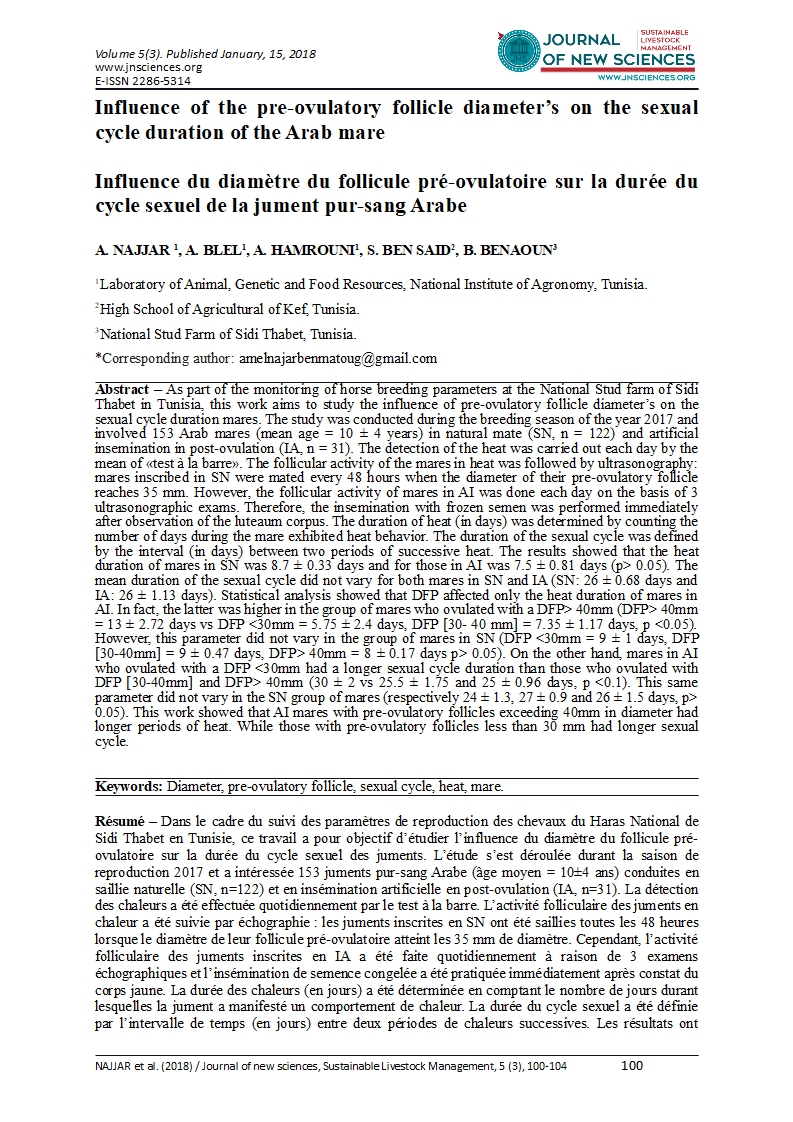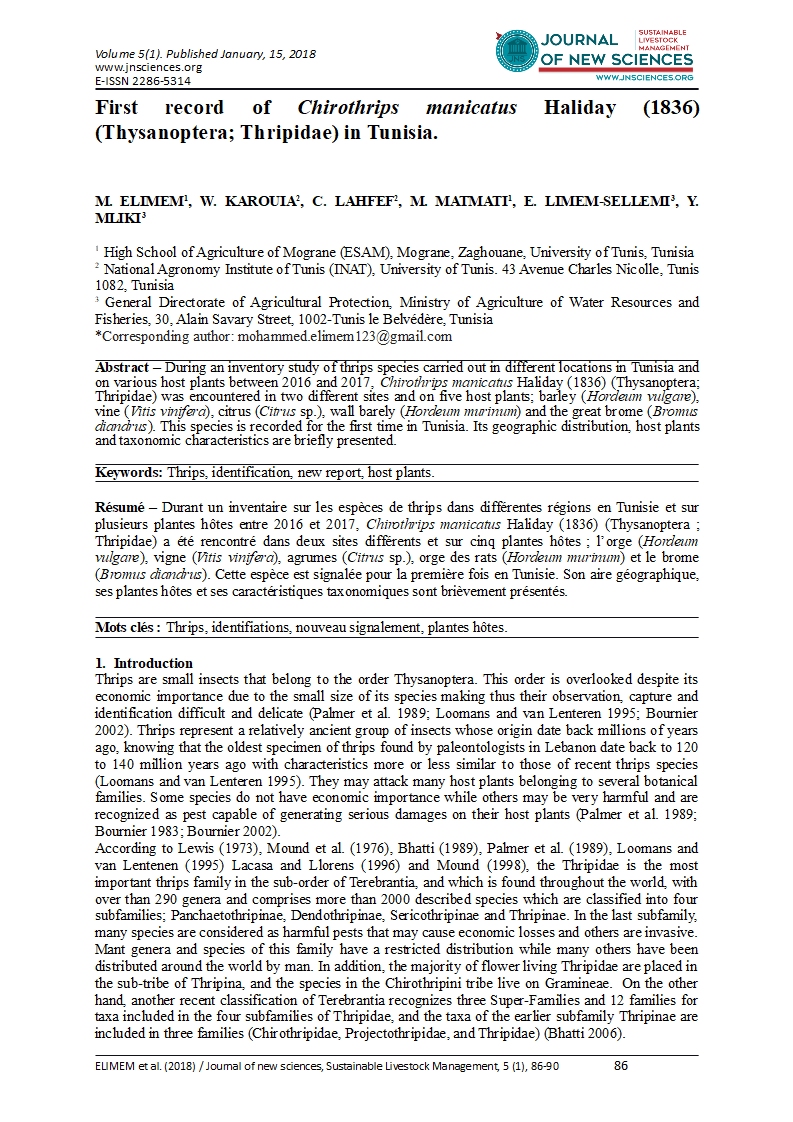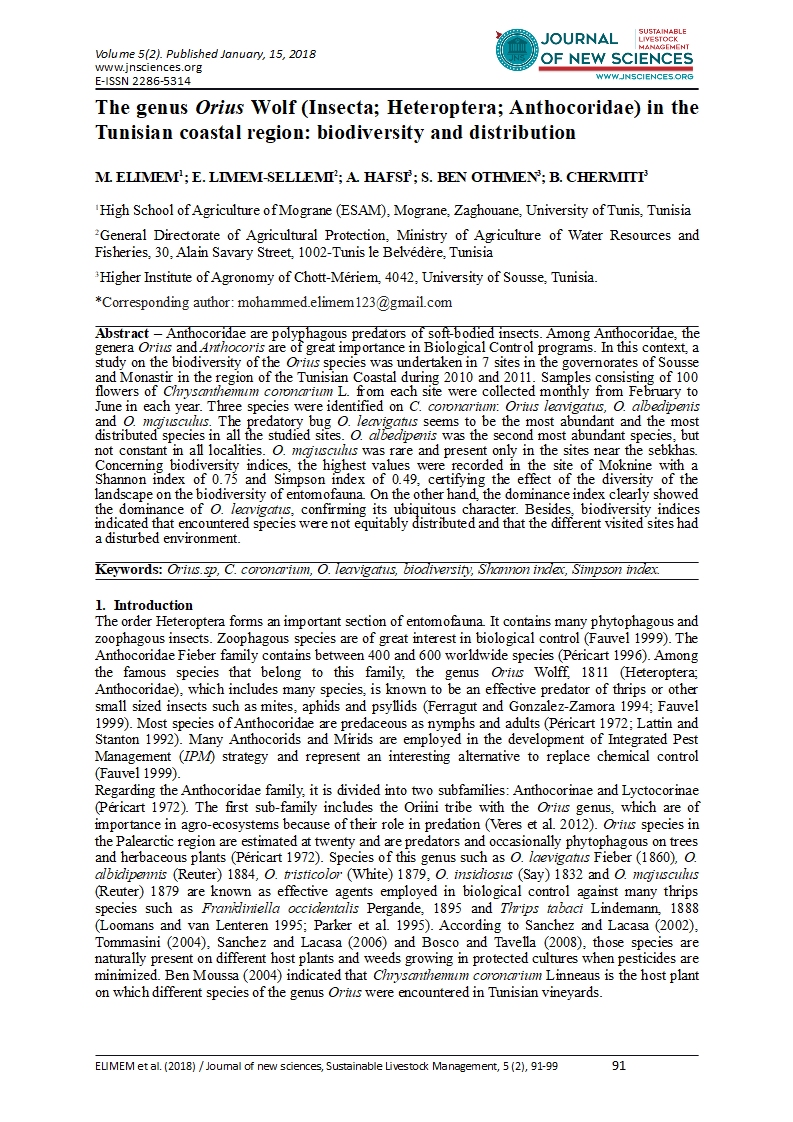- Category: Volume 5
- Hits: 10918
Influence of the pre-ovulatory follicle diameter’s on the sexual cycle duration of the Arab mare

Influence du diamètre du follicule pré-ovulatoire sur la durée du cycle sexuel de la jument pur-sang Arabe
A. NAJJAR 1
A. BLEL1
A. HAMROUNI1
S. BEN SAID2
B. BENAOUN3
1Laboratory of Animal, Genetic and Food Resources, National Institute of Agronomy, Tunisia.
2High School of Agricultural of Kef, Tunisia.
3National Stud Farm of Sidi Thabet, Tunisia.
Abstract – As part of the monitoring of horse breeding parameters at the National Stud farm of Sidi Thabet in Tunisia, this work aims to study the influence of pre-ovulatory follicle diameter’s on the sexual cycle duration mares. The study was conducted during the breeding season of the year 2017 and involved 153 Arab mares (mean age = 10 ± 4 years) in natural mate (SN, n = 122) and artificial insemination in post-ovulation (IA, n = 31). The detection of the heat was carried out each day by the mean of «test à la barre». The follicular activity of the mares in heat was followed by ultrasonography: mares inscribed in SN were mated every 48 hours when the diameter of their pre-ovulatory follicle reaches 35 mm. However, the follicular activity of mares in AI was done each day on the basis of 3 ultrasonographic exams. Therefore, the insemination with frozen semen was performed immediately after observation of the luteaum corpus. The duration of heat (in days) was determined by counting the number of days during the mare exhibited heat behavior. The duration of the sexual cycle was defined by the interval (in days) between two periods of successive heat. The results showed that the heat duration of mares in SN was 8.7 ± 0.33 days and for those in AI was 7.5 ± 0.81 days (p> 0.05). The mean duration of the sexual cycle did not vary for both mares in SN and IA (SN: 26 ± 0.68 days and IA: 26 ± 1.13 days). Statistical analysis showed that DFP affected only the heat duration of mares in AI. In fact, the latter was higher in the group of mares who ovulated with a DFP> 40mm (DFP> 40mm = 13 ± 2.72 days vs DFP <30mm = 5.75 ± 2.4 days, DFP [30- 40 mm] = 7.35 ± 1.17 days, p <0.05). However, this parameter did not vary in the group of mares in SN (DFP <30mm = 9 ± 1 days, DFP [30-40mm] = 9 ± 0.47 days, DFP> 40mm = 8 ± 0.17 days p> 0.05). On the other hand, mares in AI who ovulated with a DFP <30mm had a longer sexual cycle duration than those who ovulated with DFP [30-40mm] and DFP> 40mm (30 ± 2 vs 25.5 ± 1.75 and 25 ± 0.96 days, p <0.1). This same parameter did not vary in the SN group of mares (respectively 24 ± 1.3, 27 ± 0.9 and 26 ± 1.5 days, p> 0.05). This work showed that AI mares with pre-ovulatory follicles exceeding 40mm in diameter had longer periods of heat. While those with pre-ovulatory follicles less than 30 mm had longer sexual cycle.
Keywords: Diameter, pre-ovulatory follicle, sexual cycle, heat, mare.
Résumé – Dans le cadre du suivi des paramètres de reproduction des chevaux du Haras National de Sidi Thabet en Tunisie, ce travail a pour objectif d’étudier l’influence du diamètre du follicule pré-ovulatoire sur la durée du cycle sexuel des juments. L’étude s’est déroulée durant la saison de reproduction 2017 et a intéressée 153 juments pur-sang Arabe (âge moyen = 10±4 ans) conduites en saillie naturelle (SN, n=122) et en insémination artificielle en post-ovulation (IA, n=31). La détection des chaleurs a été effectuée quotidiennement par le test à la barre. L’activité folliculaire des juments en chaleur a été suivie par échographie : les juments inscrites en SN ont été saillies toutes les 48 heures lorsque le diamètre de leur follicule pré-ovulatoire atteint les 35 mm de diamètre. Cependant, l’activité folliculaire des juments inscrites en IA a été faite quotidiennement à raison de 3 examens échographiques et l’insémination de semence congelée a été pratiquée immédiatement après constat du corps jaune. La durée des chaleurs (en jours) a été déterminée en comptant le nombre de jours durant lesquelles la jument a manifesté un comportement de chaleur. La durée du cycle sexuel a été définie par l’intervalle de temps (en jours) entre deux périodes de chaleurs successives. Les résultats ont montré que la durée des chaleurs des juments en SN a été de 8,7±0,33 jours et celle des juments en IA de 7,5±0,81 jours (p>0,05). La durée moyenne du cycle sexuel n’a pas varié chez les juments en SN et IA (SN : 26±0,68 jours et IA : 26±1,13 jours). L’analyse statistique a montré que le DFP a affecté uniquement la durée des chaleurs des juments en IA. En effet, cette dernière a été plus élevée chez le groupe de juments ayant ovulés avec un DFP>40mm (DFP>40mm=13±2,72 jours vs DFP<30mm =5,75±2,4 jours, DFP [30-40mm]= 7,35±1,17 jours ; p<0,05). Toutefois, ce paramètre n’a pas varié chez le groupe de juments en SN (DFP<30mm =9±1 jours, DFP [30-40mm]= 9±0,47 jours, DFP>40mm=8±0,17 jours ; p>0,05). D’autre part, les juments en IA ayant ovulées avec un DFP<30mm ont eu une durée du cycle sexuel plus élevé que celles ayant ovulées avec des DFP [30-40mm] et DFP>40mm (30±2 vs 25,5±1,75 et 25±0,96 jours ; p<0,1). Ce même paramètre n’a pas varié chez le groupe de juments en SN (respectivement 24±1,3, 27±0,9 et 26±1,5 jours ; p>0,05). Ce travail a permis de conclure que les juments en IA ayant des follicules pré-ovulatoires dépassant les 40mm de diamètre ont eu des périodes de chaleurs plus longues. Alors que celles ayant des follicules pré-ovulatoires inférieurs à 30 mm ont eu un cycle sexuel plus long.
Mots clés : Diamètre, follicule préovulatoire, cycle sexuel, chaleurs, jument.
1. Introduction
Les juments sont des femelles polyoestrales à activité ovarienne cyclique et saisonnière pendant les jours longs (Guillaume 1996). De plus, le cycle sexuel de la jument, défini par l’intervalle de temps en jours entre deux périodes de chaleurs successives, varie de 18 à 25 jours (Sendel 2010). Cette variabilité est attribuée à des facteurs intrinsèques et extrinsèques (Margat et Ferry 2015). D’autant plus, il a été rapporté que les variations extrêmes du cycle sexuel sont souvent associées à des variations de la fertilité des juments durant la saison de reproduction (Benaoun 2007).
L’objectif de ce présent travail consiste à étudier l’effet du diamètre du follicule préovulatoire sur la durée du cycle sexuel, ainsi que la durée des chaleurs des juments pur-sang arabe nées et élevées en Tunisie.
2. Matériel et Méthodes
2.1. Généralités
L’étude s’est déroulée dans le Haras National de Sidi Thabet, relevant de la Fondation Nationale de l’Amélioration de la Race Chevaline (F.N.A.R.C), sur une période de 3 mois, du 15 Février au 15 Mai 2017. Un nombre total de 153 juments pur-sang Arabe (âge moyen = 10±4 ans) conduites en saillie naturelle (SN, n=122) et en insémination artificielle en post-ovulation (IA, n=31) ont fait l’objet de cette expérience.
2.2. Conduite de la reproduction
Détection des chaleurs :
La détection des chaleurs a été effectuée quotidiennement par le test à la barre. Cette action se fait quotidiennement y compris les dimanches et les jours fériés à 7h du matin dans la cour de saillie, et en présence d’un étalon entier détecteur de chaleur dit souffleur. Lorsque la jument est détectée en chaleur, elle est envoyée à la salle d’échographie pour un suivi quotidien de l’activité folliculaire.
Suivi de l’activité folliculaire et insémination :
L’activité folliculaire des juments en chaleur a été suivie par échographie : chaque jument inscrite en SN a subi un examen échographique toutes les 48 heures et dés que la taille du follicule pré-ovulatoire atteint les 35 mm de diamètre, elle est saillie par l’étalon tous les 2 jours jusqu’à constat du corps jaune. Pour le groupe des juments inscrites en IA, l’activité folliculaire a été faite quotidiennement à raison de 3 examens échographiques (9h, 16h et 23h). Ensuite, l’insémination de semence congelée avec la technique profonde a été pratiquée immédiatement après constat du corps jaune ; c’est la méthode dite profonde en post-ovulation.
2.3. Paramètres calculés
La durée des chaleurs (en jours) a été déterminée en comptant le nombre de jours durant lesquelles la jument a manifesté un comportement de chaleur.
La durée du cycle sexuel a été définie par l’intervalle de temps (en jours) entre deux périodes de chaleurs successives.
2.4. Analyses statistiques
L’analyse de la variance des données a été effectuée par le logiciel SAS (SAS Institute Inc) en utilisant la procédure GLM (General Linear Model). Pour cela, les juments de chaque mode de reproduction (SN/IA) ont été réparties en 3 groupes en fonction de la taille du diamètre de leurs follicules pré-ovulatoire : DFP<30mm ; DFP [30-40mm] ; DFP>40mm. Le test DUNCAN a été utilisé pour comparer les variables durées de chaleurs et du cycle sexuel entre les modes de reproduction et les catégories du DFP. Le seuil de signification a été fixé pour p <0,05.
3. Résultats et Discussion
La durée des chaleurs (Tableau 1) a varié de 7,5 jours pour les juments en IA à 8,7 jours pour les juments en SN (p=0,5398). Les valeurs obtenues dans notre étude sont supérieures à celles rapportées par Tibary et al. (1994) et Najjar (2005). De plus, Najjar (2005) a rapporté dans une étude traitant des données de reproduction des juments conduites en SN sur 4 ans (2000-2004), une durée de chaleur de 5 jours avec des extrêmes de 2 et 13 jours. Toutefois, la durée du cycle sexuel n’a pas varié entre les juments en SN et celles en IA (26 jours, p=0,1679). Cette valeur est légèrement supérieure à celles rapportées par Najjar et Ben Mrad (2008) pour le cas des juments en SN et Dghais (2016) pour le cas des juments en IA (24 jours). Ces différences observées dans les durées des chaleurs et cycles sexuels pourraient être attribuées à l’effet des années d’une part et des individus d’autre part.
|
Tableau 1 : Variation des durées de chaleurs et du cycle sexuel en fonction du mode de reproduction (moyennes ± écart-types). |
||
|
|
Durée des chaleurs (jours) |
Durée du cycle sexuel (jours) |
|
Juments en SN |
8,7±0,33 |
26±0,68 |
|
Juments en IA |
7,5±0,81 |
26±1,13 |
Concernant l’effet du diamètre préovulatoire DFP, ce dernier n’a pas affecté la durée des chaleurs des juments en SN (DFP<30mm =9±1 jours, DFP [30-40mm] = 9±0,47 jours, DFP>40mm=8±0,17 jours ; p>0,05 ; Figure 1).
|
|
|
a, b : p <0,05 DFP : diamètre du follicule préovulatoire
|
|
Figure 1. Variation de la durée des chaleurs des juments en SN en fonction du diamètre du follicule préovulatoire (moyennes ± écart-types). |
En revanche, la durée des chaleurs des juments en IA a été affectée par le diamètre du follicule préovulatoire DFP (Figure 2). En effet, ce paramètre a été plus élevé chez le groupe de juments ayant ovulés avec un DFP>40mm (DFP>40mm=13±2,72 jours vsDFP<30mm =5,75±2,4 jours, DFP [30-40mm]= 7,35±1,17 jours; p=0,0998). Ces résultats ne sont pas en accord avec ceux obtenus par Ghali (2010). Cette dernière a trouvé qu’un allongement de la durée des chaleurs est associé à une diminution du diamètre du follicule préovulatoire alors qu’un raccourcissement de la durée des chaleurs est associé à une augmentation de ce diamètre. Dans notre cas, la durée des chaleurs est courte lorsque le DFP atteint des valeurs extrêmes dépassant les 40mm.
|
|
|
a,b : p <0,05 DFP : diamètre du follicule préovulatoire
|
|
Figure 2. Variation de la durée des chaleurs des juments en IA en fonction du diamètre du follicule préovulatoire (moyennes ± écart-types). |
L’analyse statistique n’a pas montré un effet du diamètre du follicule préovulatoire DFP (Figure 3) sur la durée du cycle sexuel des juments en SN (24±1,3, 27±0,9 et 26±1,5 jours respectivement pour DFP<30mm, DFP [30-40mm] etDFP>40mm ; p=0,7875).
|
|
|
DFP : diamètre du follicule préovulatoire
|
|
Figure 3. Variation de la durée du cycle sexuel des juments en SN en fonction du diamètre du follicule préovulatoire (moyennes ± écart-types). |
D’autre part, les résultats ont montré que pour le groupe de juments en IA, le diamètre du follicule préovulatoire DFP tend à affecter leur durée du cycle sexuel (Figure 4). En effet, les juments en IA ayant ovulées avec un DFP<30mm ont eu une durée du cycle sexuel plus élevé que celles ayant ovulées avec des DFP [30-40mm] et DFP>40mm (30±2 vs 25,5±1,75 et 25±0,96 jours ; p=0,0998). Ceci est en accord avec les résultats de Benaoun et al. (2010) qui a rapporté le même effet sur la durée du cycle des juments. De plus, dans une autre étude, Benaoun (2007) a rapporté que le gros follicule ne donne souvent pas un meilleur ovocyte et donc une meilleure fertilité. Il a considéré qu’il y a une catégorie des follicules (35 à 49mm) pour lesquels la fertilité est optimale (>50%).
|
|
|
Figure 4 : Variation de la durée du cycle sexuel des juments en IA en fonction du diamètre du follicule préovulatoire (moyennes ± écart-types). |
4. Conclusion
Cette étude a permis de conclure que les juments en IA ayant des follicules pré-ovulatoires dépassant les 40mm de diamètre ont eu des périodes de chaleurs plus longues. Alors que celles ayant des follicules pré-ovulatoires inférieurs à 30 mm ont eu un cycle sexuel plus long. Certes que ces résultats laissent penser qu’il aurait un effet de la variation du diamètre du follicule préovulatoire sur la fertilité des juments. De ce fait, il serait judicieux d’étudier le taux de mise-bas en fonction des classes des diamètres du follicule préovulatoire afin de confirmer son effet sur la fertilité.
5. Références
Benaoun B (2007) Etude échographique de la dynamique folliculaire chez la jument pur-sang Arabe durant la saison de monte. Mémoire de mastère, Institut National Agronomique de Tunisie, 77p.
Benoun B, Najjar A, Ben Mrad M, Ezzaouia M (2010) Suivi de l’activité folliculaire par échographie transrectale chez la jument Pur-sang Arabe durant la saison de reproduction. Proceeding du 27ème Congrès Vétérinaires Maghrébins, 10 et 11 avril, Hammamet, Tunisie.
Dghais L (2016) L’insémination artificielle profonde post-ovulation chez la jument : quels résultats de fertilité ? Mémoire de projet de fin d’études. Institut National Agronomique de Tunisie, 57p.
Ghali I (2010) Etude des facteurs des facteurs de variation de la fertilité de la jument pur-sang Arabe au Haras National de Sidi de Thabet. Mémoire de mastère. Institut National Agronomique de Tunisie,89p.
Guillaume D (1996) Action de la photopériode sur la reproduction des équidés. INRA Prod. Anim., 91, 61-69.
Margat A, Ferry B (2015) Gestion de la jument reproductice. Fiche technique, Institut français du cheval et de l’équitation, 3p. www.haras-nationaux.fr
Najjar A (2005) Contribution à l’étude de la fertilité de la jument Pur Sang Arabe en saillie naturelle dans le Haras de Sidi Thabet. Mémoire de mastère, Institut National Agronomique de Tunisie, 52p.
Najjar A, Ben Mrad M (2008) Etude des paramètres de fertilité des chevaux pur sang arabe en saillie naturelle dans le Haras National de Sidi Thabet. El Baytary, n°49-50, pp 24-27.
Sendel T (2010) Le cheval, anatomie, physiologie et reproduction de la jument. Fiche technique, Institut français du cheval et de l’équitation, 4p. www.haras-nationaux.fr
Tibary A, Anouassi A, Bakkoury M (1994) Physiologie de la reproduction chez la jument. Chapitre 2, Reproduction équine, tome I. Institut Agronomique et Vétérinaire Hassan II. Editions Rabat, 21-49.


